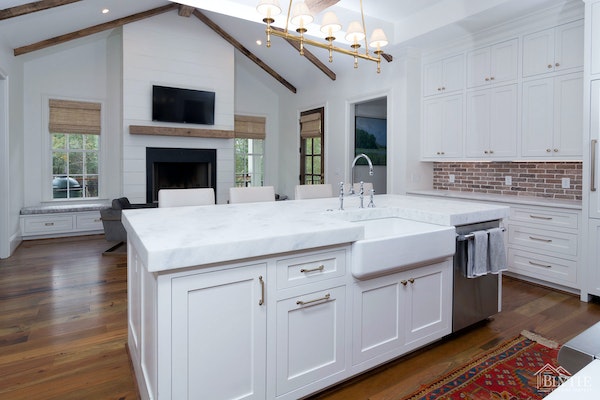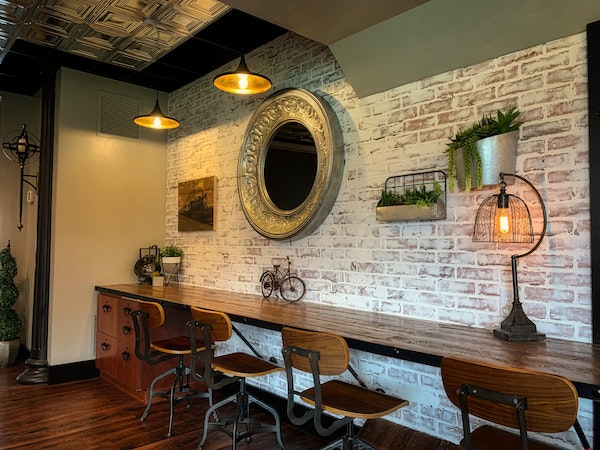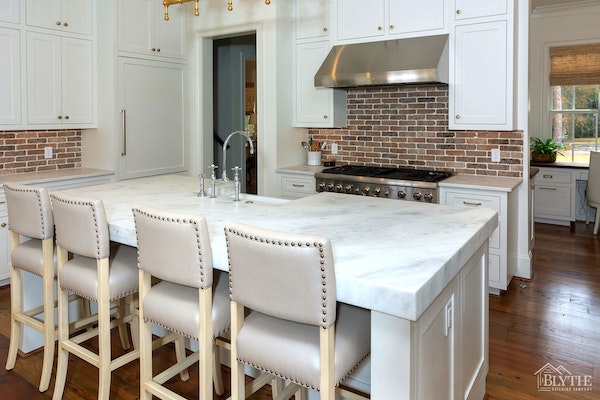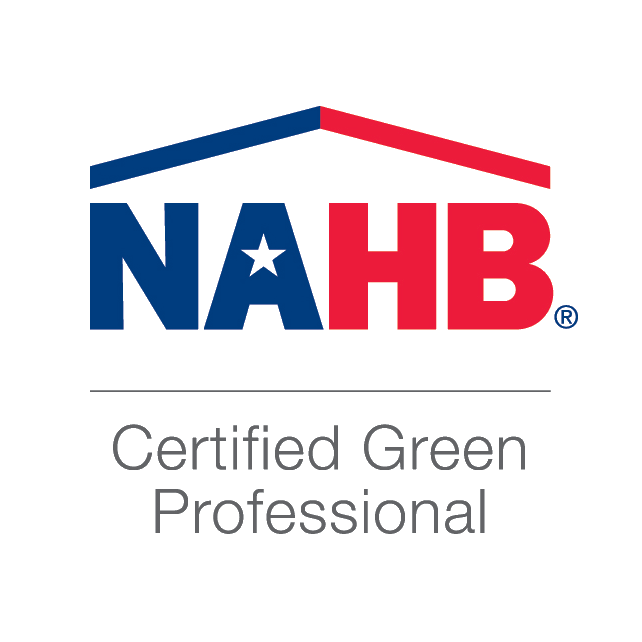Farmhouse kitchen brick backsplash: The backsplash above was created using The Exum Co’s thin brick.
The practical purpose of a backsplash is to protect the wall from water and splattering that may come during the cooking process or during washing up after meals. But today, a backsplash does a lot more than protect your walls. It adds texture, color, and character to help you personalize your kitchen and showcase your style.
You’ve got plenty of options when it comes to a kitchen backsplash. Stacked stone, glass tile, ceramic tile, metal tile, granite, marble, or other natural stone are all beautiful choices.
But there’s something about a brick backsplash that warms the atmosphere of your kitchen like nothing else, bringing in that sense of “the heart and hearth of the home.” It has become increasingly common in luxury homes as people want something more unique with a sense of history in their living spaces.
Brick is part of a large design trend in kitchens for floors and walls that is here to stay.
If you are considering a brick-style backsplash as a focal point for your dream kitchen, maybe you’d like to know what your options are. Let’s look at them together and help you find just the right kitchen backsplash for your taste and if brick will work well with the architectural style of your home and kitchen.
What Types of Brick Backsplashes Are There?
You have many choices for bringing a beautiful brick focal point into your kitchen plans. Ultimately, consider the aesthetics you desire, the functionality, cleaning, and maintenance that will work best for you.
If you are looking for something spectacular that will look amazing for years to come, real brick is a great choice. But it’s not the only one. Let’s look at the pros and cons of real brick and faux brick for your backsplash in your luxury kitchen or scullery.
Types of Real Brick Backsplashes
Real brick evokes nostalgia, warmth, and a depth of character like nothing else. There are two main options.
Solid brick backsplash
One option to consider is using regular bricks to create an exposed brick backsplash. Of course, it will look like a “real brick wall” because it is one!
The downside of using normal brick is that the backsplash will be quite thick (and heavy). You can definitely do it, especially if you are creating an entire brick wall for the room and you don’t mind losing a few inches of room space and your kitchen can support the extra weight.
If you only want to use brick between your kitchen counter and upper kitchen cabinets, something thinner would be much more practical than building an entire brick wall and covering most of it with cabinets.
Thin brick/brick veneer
A thin brick backsplash (or brick veneer backsplash) gives you that authentic brick look you crave — because it is real brick — but it’s only ¾ inch thick. So it’s easier to work with in a backsplash zone or even on large walls in your kitchen. This gives you all the pros of real brick and the advantages of not having as much weight, expense, and bulk to deal with.

A red brick backsplash with white cabinets makes a beautiful contrast.
Pros and Cons of Brick as a Backsplash
Every building material has its strengths and weaknesses. It’s a good idea to know your materials well before choosing them for your dream home.
The pros of real brick (thin or regular)
Brick has a rustic charm that is unsurpassed with any other material. Obviously, it’s very durable and strong. Brick can take a lot of wear and tear. You don’t have to worry about contact with heat. It’s also very unique and can give your home a one-of-a-kind feel.
You can have the brick laid in a variety of patterns like herringbone, basketweave, running bond (traditional pattern), or stack bond (with bricks in rows one stacked above the other).
Real brick speaks to luxury in modern kitchens today and shows that your kitchen has the highest quality materials. In many luxury markets, it may even add value to your home at resale (check with your builder or real estate agent about your market).
The cons of real brick
Unfortunately, untreated brick is quite absorbent. It may soak in stains from liquids that splash against it. Because of this, a solid brick backsplash (or thin brick backsplash) may need to have a coating of clear polyurethane sealant (matte or satin finish). If the brick is not sealed and comes in contact with a lot of moisture, it can eventually crumble over time.
Of course, sealing or painting can take care of a lot of these issues.
Because brick is so roughly textured and has many nooks and crannies, brick (and the mortar in between the bricks) can be difficult to clean. You may decide to have your stove and/or sink somewhere away from the brick to completely avoid any absorbency or cleaning issues. Or you may look into it and decide you are okay with cleaning the brick when needed and that it’s not a big deal.
Another issue with real brick backsplashes is that they can produce efflorescence. This is a chalky powder that is made up of white mineral deposits. Sometimes the water-soluble salts in brick migrate to the surface of the brick and become visible.
Check with your builder or designer about which type of brick might be best for you if you have concerns. There are ways to overcome problems so that you can enjoy real brick in your home.
If you use regular brick, you’ll need to have it on a load-bearing wall or have extra reinforcement to support the weight. Or you can use thin brick, like we did here, which eliminates the weight issues.

Types of Faux Brick Backsplashes
Brick-look backsplashes come in a variety of options including tiles, panels, and wallpaper. We wanted to make it a bit easier for you to find your options by getting a list of possibilities together for you with links so you can compare products for yourself.
Once we look at the types of faux brick available, we’ll get into the pros and cons of faux brick for a kitchen backsplash.
Tiles
Tiles are available in ceramic and porcelain with varying degrees of looking like real brick. Many of these tiles can be used for walls or floors.
For a wide range of options of brick-look tile backsplashes, check out Lowe’s selection.
Natural stone brick-look tiles
Natural stone like marble and travertine can make good brick substitutes.
Tumbled textured Travertine wall tile from Home Depot have the beauty and texture of natural stone with the ease of application of tile.
Polished natural marble brick-look wall tile from Lowe’s have the shape of brick with the beauty and marbling of natural marble stone if you want something a bit more refined.
Ceramic brick-look tiles
Ceramic brick-look tiles come in a variety of colors, shapes, and sizes.
Tumbled ceramic brick-look wall tile from Lowe’s have a weathered brick look that’s pretty convincing and with the right grout work, the effect is very realistic.
Ceramic brick-look subway tile by Wayfair (blue, gray, taupe, or white) are artfully painted and shaded to look like brick rather than just simply subway tile.
Porcelain brick-look tiles
Home Depot has a variety of options of porcelain tile that come in Matte finishes and can be used for the floor or the wall.
Glazed Porcelain brick-look tiles from Lowe’s have a wide range of colors in each pack with beige, browns, and even black in the mix. The overall effect is weathered and rustic.
Porcelain brick-look tile from Wayfair come in colors like Gray, Mud, Old Red, or Sand. These tiles look almost exactly like weathered brick.
Matte porcelain tile from Home Depot look like white brick for an understated look without any gloss or shine. Use different colored grouts to complement your kitchen’s color palette.
Broadway Brick Red Porcelain Subway Tile by Ocean Mosaics have a weathered brick appearance for a rustic look. The size of the tile looks just like brick and there is a slight texture to it. But with the glaze coating, it is easy to clean.
Panels
Panels are easy to install and lightweight. You get a true 3D brick effect. Use these panels between your counter and upper cabinets. Or use them for an entire wall.
High-Density Polyurethane brick panels from Barron Designs are very realistic and durable panels. Choose from Old Chicago, Traditional Brick, or Contempo Brick.
Faux brick panels/PVC faux brick panels from Amazon are an easy way to add a rustic look to your backsplash.
Foam 3D faux brick waterproof panels from Amazon might work if you want to be able to scrub your backsplash with a wet cloth or you need something that can hold up to the splashes around the sink.
For more, check out the faux brick panel selection from Home Depot and Lowe’s.
Wallpaper
Wallpaper is back in 2022! The newest wallpaper is also self-adhesive (peel-and-stick) and is easy to remove. (Unlike the older generations of wallpaper that were a tremendous hassle to remove.)
There are plenty of pre-made designs or you can have your own custom HD wallpaper made if you prefer. You can even add your own personalized graffiti. (Although that may be better for a kid’s room than a kitchen backsplash. Depending on the effect you are going for.)
Some wallpaper options:
Flat HD wallpaper with 3D effect from Amazon
Brick wallpaper murals from Hovia.com
Textured 3D wallpaper from Amazon
Wallpaper foam tile from Amazon
Pros and Cons of A Faux Brick Backsplash
While a “fake brick backsplash” might not be for everyone, there can be some definite advantages to not using real brick. You can get the look of brick without the maintenance and hassles of real brick.
Pros of Faux Brick
If the absorbency, efflorescence, sealing, maintenance, and cleaning issues for real brick give you pause, faux brick may be the better option for you. Faux brick won’t be affected by humidity or moisture. And the color won’t fade the way it could with real brick.
Faux brick generally costs a lot less than real brick. And it is a lot easier to install. Most types of faux brick are quite durable and will last for years. They may be easier to remove than real brick, as well.
Cons of Faux Brick
Some types of faux brick can look cheap or tacky. Not the look you are going for if you want a high-end kitchen.
Faux brick probably won’t increase the value of your home. And, if it doesn’t look right, it could hurt your resale value.
It may require grout or caulking. If you get a panel or wallpaper, you can’t usually do much to arrange the faux bricks in a different pattern.
Faux brick, if made of PVC, may be flammable, but most types are treated to make them fire-resistant.
Some faux brick has a lot of texture and can be more difficult to clean than a smooth tile surface would be.

What type of interior design styles work for installing a brick backsplash?
Not every kitchen design style works with brick. If you want to have a Traditional, Beach, Asian, or Scandinavian style, for example, there could be other better backsplash options to match your interior design.
Many popular kitchen styles pair beautifully with a brick backsplash design
Our favorites include:
Contemporary — This style works well with brick, glass, steel, metal, and wood.
French-style — French kitchens employ natural stone, brick, and wood to bring an Old World feel.
Farmhouse — For Farmhouse or Craftsman style kitchens, rustic wood, brick, or natural stone help to create the effect.
Industrial/Modern — This style uses plenty of metal, glass, wood, and brick.
Mediterranean — For a Mediterranean vibe, think natural stone, worn brick, and dark wood.
Rustic — The more texture and history, the better with this look. Reclaimed wood beams, worn natural stone, and weathered brick are perfect for this kitchen.
Shabby Chic — Rustic meets fun contemporary with this look. Get the rustic part by using weathered or reclaimed wood, distressed effects, weathered brick or natural stone, or whitewashing.
Tuscan — This timeless Italian look utilizes the finest natural materials like natural wood, natural stone (travertine or marble), and matte metals.
How Much Does a Brick Backsplash Cost?
The general cost to purchase and install real brick is about $12 to $20 per square foot (at the time of the writing of this post) — but can go much higher depending on if you decide to use specialty bricks, you have a particularly difficult job, or if you want an intricate pattern.
What Color Brick Backsplashes Are Available?
Brick can come in almost any color you can imagine. Some of the most popular colors for brick backsplashes are:
- Black brick backsplash — Works well with a Modern or Industrial kitchen.
- Brown brick backsplash — Perfect for a Tuscan, Italian, or Rustic look.
- Gray brick backsplash — A fantastic choice for a Modern or Industrial aesthetic.
- Red brick backsplash — Can’t go wrong with this classic look for most kitchen styles.
- Weathered brick backsplash — Great for a Farmhouse, Industrial, Modern, or Rustic kitchen.
- White brick backsplash — A beautiful fit for a Farmhouse, Industrial, or Craftsman kitchen.
- Whitewashed brick backsplash – Also wonderful for a Farmhouse, Craftsman, or Industrial kitchen.
If you don’t find just the right color for your palette, go with painted brick so that you can match up your backsplash to your decor. The right paint covering can also make cleaning easier and prevent the brick from absorbing stains and splatters.
Cleaning Brick/Sealing Brick
Check with your builder about whether you need to seal your brick backsplash. Some products do just fine without sealant. But others may do better with a special brick sealant, although it could affect the color.
To clean brick, check with your specific manufacturer and only use the instructions for the exact type of brick you have for best results so that you don’t cause any damage. Overall, avoid most acid-based cleaners or anything too abrasive. (Instructions for cleaning Meridian Brick — as shown in our images — can be found here.)

Ready to Dive Into a Building Your Dream Home Using Brick?
We can help! We have experience building custom homes with custom thin brick backsplashes and we can help you build the home of your dreams using brick in many other ways, as well.
If you are looking for a custom home builder in the Lexington, SC area to build your luxury home, we invite you to take a look at our portfolio.
Related
Microwave Drawers: A New Necessity for Luxury Kitchens?
Are Solid Wood Kitchen Cabinets Right for You? Pros and Cons
Which Is Better? Quartz vs Quartzite for Kitchen Countertops







